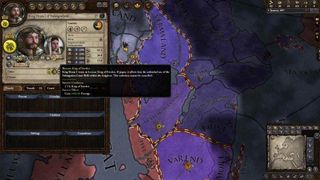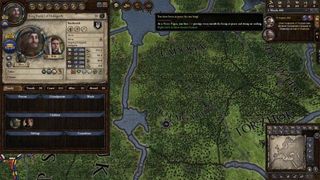
Welcome back to our Viking Analysis Desk for a look at the third development diary for The Old Gods, the upcoming, pagan-focused expansion for Crusader Kings II. This entry focuses on prepared invasions, and clarifies some information about which types of pagans will be able to do what, and to whom. Let's dive in...

Immediately, in this first screenshot, we can see confirmation of a Scandinavian portrait pack. That hasn't exactly been a secret for those who have been paying attention, but it's good to see some more variety being injected into the mix in terms of character faces. It's also hard to tell from this resolution, but it kind of looks like the unit model on Akershus, just above the tooltip, might be new. Every major expansion so far has also launched alongside a unit pack, so again, nothing too earth-shattering.
We also get a look at the new "Become King" ambition, demonstrated briefly in the Old Gods livestream , which allows pagans to get a free Subjugation casus belli on any other pagan ruler within the de jure realm they seek to control. Based on the wording of the dev diary, it sounds like this Subjugation system will only work with pagans fighting other pagans, but is not restricted by culture.
We can also see the new Petty Kingdom system in play. The border on Hrane's portrait indicates that he's a Duke-tier ruler, but due to his culture, his written title will be "King."

In this second screen, history buffs should be drawn to the lower right of the interface. It seems the three successor kingdoms of Charlemagne's Karling dynasty have been renamed from Francia, Burgundy, and The Holy Roman Empire to the more 867-appropriate East Francia, Lotharingia, and West Francia. What will cause them to revert to their original names by the time 1066 rolls around, your guess is as good as mine. We know the historical names in Scandinavia are tied to the new "Norse" culture, which will eventually splinter into Danish, Norwegian, and Swedish. It's possible that the existing "Frankish" culture has been changed to refer to earlier Frankish people, and will, at some point, evolve into "French."
Scotland, it seems, is still called Scotland, rather than the 867-appropriate Strathclyde. And thus the case of Official Forums v. Game Designer Chris King shall continue.
More excitingly, we get a look at the Prepared Invasion mechanic we've heard about, which allows leaders with relatively few feudal holdings to call on warriors from across the land to aid their conquests. It looks like this will be restricted only to Norse pagans, and require a one-time expenditure of 500 prestige. The diary also clarifies that Prepared Invasions will only be usable against non-pagans.
PC Gamer Newsletter
Sign up to get the best content of the week, and great gaming deals, as picked by the editors.

Finally, we have this image of good ol' Rurik, the Norse founder of the state that would become modern Russia. There isn't a whole lot new in this one that isn't already pretty commonly known about the expansion, but we do get our first look at the indicator for non-reformed Norse pagans taking prestige loss for going too long without warring or raiding. For those interested in minutiae, we can also see that Rurik is Attractive, Gregarious, Ambitious, Just, and Deceitful.
The other little tidbits we got from the diary deal with the Invasion casus belli. Like Muslims, any pagan can declare an invasion on any neighboring county. For Norse pagans, this ability extends to any coastal county on the map, making their naval mobility all the more intimidating. Granted, we have been told that navigable rivers do not count as coastline, so they won't be able to just invade, say, Paris, on a whim. That's what raids are for.
Additionally, Altaic pagans (notably the Mongols), as well as the nomadic Magyars, who go on to become the Hungarians by 1066, will be able to declare invasions of entire kingdoms with their mounted hordes.
I've been drafting a weighty scroll of questions for the Paradox team about the Old Gods, which will be dispatched to them by raven before the day is out. Keep a keen eye for the full Q&A on the near horizon.
Most Popular





